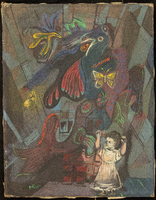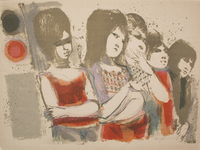Ruth Gikow
1946
Acrylic on canvas
13 1/2 in. x 10 3/4 in.
Gift of Leonard & Ruth Bocour
Children
1960
Lithograph
Image: 22 in. x 27 5/8 in.
Sheet: 22 in. x 28 3/4 in.
Gift of Leonard & Ruth Bocour
Ruth Gikow (1915-1982) was a Jewish painter best known for her surreal and stylized renditions of the human figure. Her works are often set within an urban environment and incorporate imagery of a city, such as streetlights, bricks, or alleyways, perhaps due to her upbringing in New York City.1 Her style ranges anywhere from Abstract Expressionism to Cubism to naturalism, depending on the piece in question.
Gikow had a range experience in the art world, as she was the daughter of portrait photographer, Boris Gikow, and then attended Cooper Union Art School where she studied under John Steuart Curry (1897-1946) and Austin Purvis, Jr. (1900-1977). She was consistently influenced by the art and artists around her, so much so that she was heavily engrossed in her work and ignored the typical diversions as a teenager, which is a possible reason for her common choice of young subjects.2
A work in which this is evident is Girl with Butterfly (1946), a painting that depicts a child-like female figure standing alarmingly in front of a wall of bright, surreal, and disturbing imagery. The painting is rendered with thick brush strokes that leave an obvious texture on the surface of the canvas. The child-like figure is rendered realistically, yet the position and gesture makes the girl appear to be frightened and uncomfortable. The figure’s face is excessively detailed, yet the expression is blank, despite the pose of the figure. Colors are dulled shades of pink, yellow, and grey in the figure, yet the wall behind holds a spectrum of colors in dark saturation. Blues, greens, reds, yellows, and purples litter the wall in fluid strokes to represent undefinable imagery. The only imagery found in the background to be transparent in its approach is the butterfly. A pair of bright yellow butterflies can be clearly viewed against the dark background towards the center of the vertical composition.
Later in life, along with fellow artists, Gikow founded the American Serigraph Society, whose members wished to create numerous original prints and pieces in a reasonable price range for the average citizen.3 This interest in printing and serigraphs is obvious in her later works, especially those with commercial imagery, but began with her involvement in the New York City Works Project Administration (WPA) Federal Art Project, for which she produced mural designs and prints.4
One of the works which demonstrates her printing experience is a lithograph in the College collection titled Children and dated 1960. It is a colored piece on taupe paper depicting a row of teenage figures in various positions of boredom or defiance in front of what appears to be a street light. The color palette is a bright combination of warm and cool shades on top of a neutral grey outline. The clothing and streetlight are the only objects of color, while the human figure’s hair, skin, and features are defined by the grey outline and negative space of the paper. The human figures are rendered naturalistically, yet there are features present that are unusual such as a dark blue slash across a female figure’s eyes, blurring them out, or the vague, nearly incomplete depiction of the figures’ hands.
1. Susan Chevlowe, "Ruth Gikow," Jewish Women: A Comprehensive Historical Encyclopedia, March 1 2009. Accessed October 25, 2016. http://jwa.org/encyclopedia/article/gikow-ruth.↩
2. Matthew Josephson, Ruth Gikow (New York: Maecenas Press, 1970), 10.↩
3. Ibid, 11.↩
4. Ibid, 13 and "Oral History Interivew with Ruth Gikow, 1964," Archives of American Art. Accessed March 16, 2017. https://www.aaa.si.edu/collections/interviews/oral-history-interview-ruth-gikow-12598.↩
-Julianna Linder


